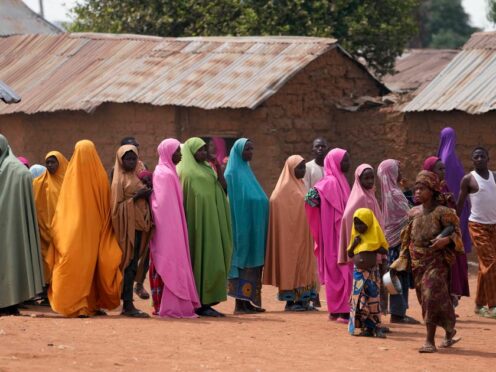At least 137 of nearly 300 Nigerian children abducted more than two weeks ago from their school in the north-western state of Kaduna were released on Sunday, military officials have said.
An earlier statement from the Government had suggested all the students were freed.
Motorcycle-riding gunmen invaded the Kuriga school on March 7 and marched the children into the forests before security forces could arrive as terrified families watched helplessly.
School authorities said a total of 287 students were kidnapped during the attack, at least 100 of them are aged 12 or younger.
The 137 children were rescued in Zamfara state, an enclave known for kidnappings more than 120 miles away from their school, Nigerian military spokesman Major General Edward Buba said in a statement.
“Efforts would continue until other hostages are found and the terrorists arrested, tried and brought to justice by Nigerian law,” Mr Buba said.
At least 17 other schoolchildren in northern Sokoto state were also rescued two weeks after they were taken hostage, according to a statement issued on Saturday by the Sokoto state government.
Kaduna state governor Uba Sani, who first announced the rescue, did not give details about the operation. His office could not be reached on Sunday to clarify the discrepancy in the number of those freed.
The Associated Press could not reach villagers in Kuriga town, where mobile network is not available.

At least 1,400 students have been kidnapped from Nigerian schools since 2014, when Boko Haram militants seized hundreds of schoolgirls from Borno state’s Chibok village.
In recent years, abductions have been concentrated in the country’s north-western and central regions, where dozens of armed groups often target villagers and travellers for ransom.
Under growing pressure to end the mass kidnappings in northern Nigeria, President Bola Tinubu promised his administration is “deploying detailed strategies to ensure that our schools remain safe sanctuaries of learning, not lairs for wanton abductions”.
Mr Tinubu had vowed to rescue the children “without paying a dime” as ransom. Ransoms are commonly paid for kidnappings, often arranged by families, and it is rare for officials in Nigeria to admit to the payments.
No group has claimed responsibility for the Kaduna kidnapping, which locals have blamed on bandit groups known for mass killings and kidnappings for ransom in the conflict-battered northern region, most of them former herders in conflict with settled communities.
Arrests are rare in Nigeria’s mass kidnappings, as victims are usually released only after desperate families pay ransoms or through deals with government and security officials.
